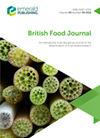支持农业食品企业循环经济决策过程的多层次工具
IF 3.4
3区 经济学
Q1 AGRICULTURAL ECONOMICS & POLICY
引用次数: 0
摘要
本研究旨在开发一个多层次框架,用于评估农业食品行业的循环性,为用户提供一个循序渐进的方法,并选择一套能够准确评估循环经济(CE)水平的定制指标。在第一阶段,实施了基于运营、产品和服务、文化、组织和生态系统标准的循环经济理论模型,并根据农业食品行业进行了调整。在第二阶段,要求用户收集一套能够衡量每项标准的指标。在第三阶段,使用层次分析法(AHP)为每个指标分配权重。最后,使用一个几何多标准决策(MCDM)模型,即基于轴向距离的聚合测量(ADAM)模型,对结果进行归一化、评估和聚合,并为不同的备选方案生成最终分数,根据其最终循环性分数进行排序。原创性/价值除了从纯粹的环境角度衡量企业绩效的循环性之外,这项研究还采用了一种全面的观点,考虑到了循环经济所有原则的复杂性和干扰性。本文章由计算机程序翻译,如有差异,请以英文原文为准。
A multi-level tool to support the circular economy decision-making process in agri-food entrepreneurship
PurposeThe present study is aimed at developing a multi-level framework for assessing circularity in agri-food industries by providing the user with a step-by-step approach and selecting a customized set of indicators capable of accurately assessing the circular economy (CE) level.Design/methodology/approachThe framework is composed of four stages. In the first stage, a CE theoretical model based on operations, product and services, culture, organization and ecosystem criteria has been implemented and adapted to the agri-food sector. In the second stage, users are required to collect a set of indicators capable of measuring each criterion. In the third stage, a weight is assigned to each indicator using analytical hierarchy process (AHP). Lastly, a geometric multi-criteria decision-making (MCDM) model, called axial distance-based aggregated measurement (ADAM) model, is used to normalize, assess and aggregate the results and produce final scores for the different alternatives to be ranked based on their final circularity scores.FindingsThe model can be a useful tool to support corporate decisions in the CE, making entrepreneurs aware of their starting level. It indicates the extent to which companies are implementing circular business models across different dimensions and, thus, where they are still lacking.Originality/valueBeyond the attempts to measure the circularity of corporate performance from a purely environmental perspective, the study adopts a holistic view, considering the complexity and disruption of all the principles of the CE.
求助全文
通过发布文献求助,成功后即可免费获取论文全文。
去求助
来源期刊

British Food Journal
工程技术-食品科技
CiteScore
6.90
自引率
15.20%
发文量
219
审稿时长
18-36 weeks
期刊介绍:
After 115 years, the British Food Journal (BFJ) continues to be highly respected worldwide for its broad and unique interdisciplinary coverage of the latest food-related double blind peer-reviewed research. It links all sectors of this dynamic industry, keeping abreast of emerging trends, topical and controversial issues and informing and stimulating debate. - See more at: http://emeraldgrouppublishing.com/products/journals/journals.htm?id=bfj#sthash.O3wH4pEh.dpuf
 求助内容:
求助内容: 应助结果提醒方式:
应助结果提醒方式:


